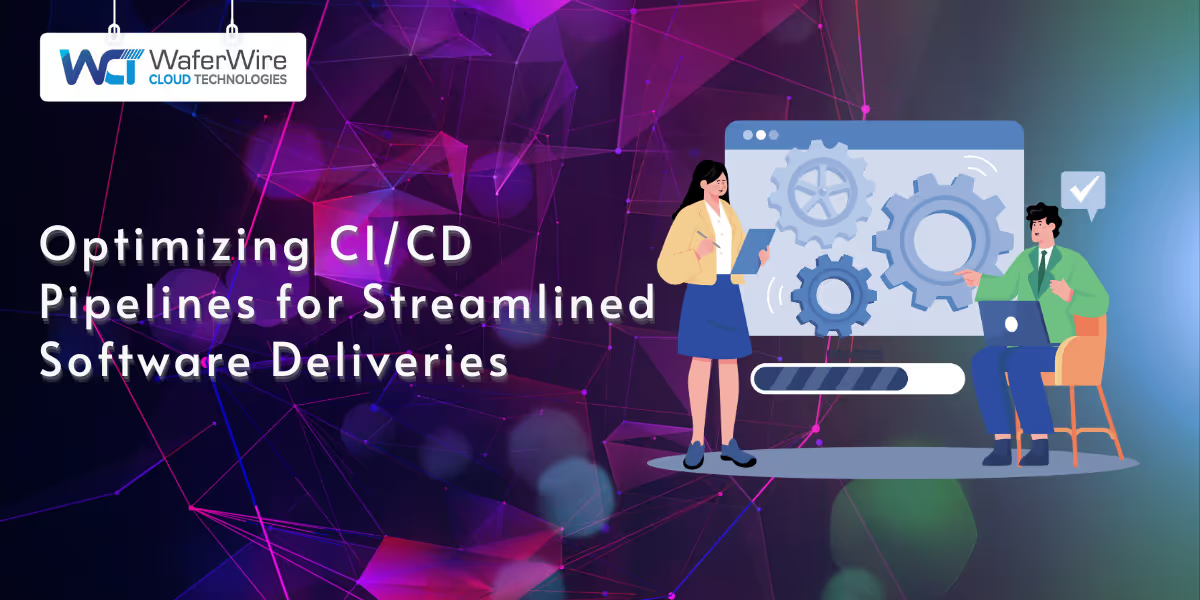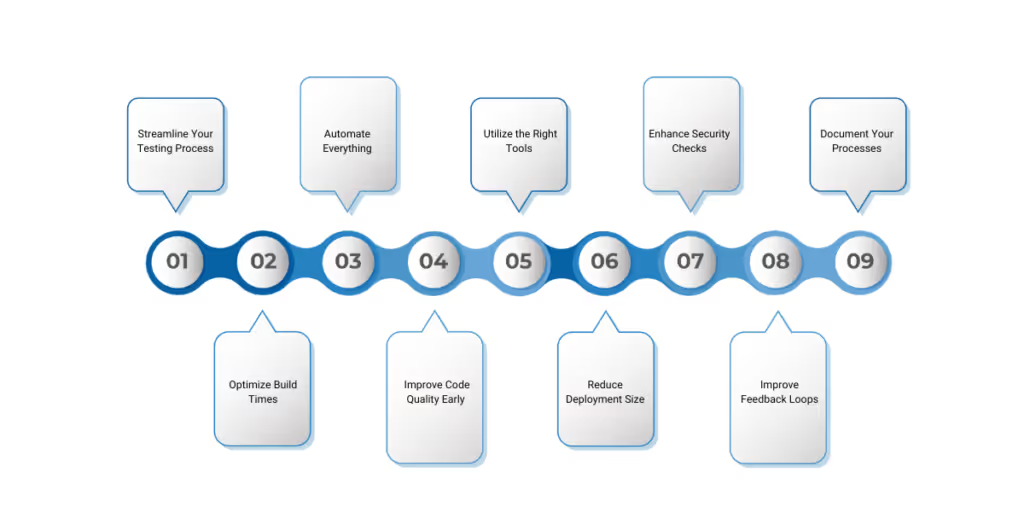


Optimizing CI/CD pipelines for faster software delivery is essential for staying ahead in today’s competitive software development environment. By refining your Continuous Integration and Continuous Deployment (CI/CD) processes, you ensure that your software is built, tested, and deployed more efficiently and with greater accuracy and quicker turnaround times.
In this guide, we’ll explore proven strategies to enhance the performance of your CI/CD pipelines. From automating tests and leveraging parallel execution to implementing smart caching techniques, we’ll cover the key practices that can significantly reduce deployment time.
With a streamlined pipeline, teams can enhance development velocity, improve overall software quality, and maintain consistency.
Optimizing your CI/CD pipelines for faster software delivery directly impacts speed. Automating tests builds, and deployments makes the development process much more efficient. This ensures the team can focus on adding value instead of getting bogged down with manual tasks or waiting for slow feedback.
Optimized CI/CD pipelines for faster software delivery help with speed and improve software releases' reliability. Automation ensures that all testing is consistent and thorough, eliminating human errors that can lead to production issues. This consistent approach allows for more frequent, reliable releases, keeping both the development team and end users satisfied.
With the clear importance of optimizing your CI/CD pipeline, let’s explore some key strategies that can help drive faster software delivery and higher-quality releases.

Optimizing your CI/CD pipeline for faster software delivery isn’t just about cutting down on build times; it’s about creating a smoother, more reliable software deployment process. The ultimate goal is to ensure that your teams can deliver high-quality software faster while reducing manual errors and maintaining security. Here are some essential strategies to help you streamline your pipeline:
Testing is often a bottleneck in CI/CD pipelines. Prioritize test suite management to ensure you’re testing effectively without overburdening the system. Classify tests into unit tests, integration tests, and end-to-end tests. Running unit tests on every commit ensures fast feedback without waiting for longer, slower tests.
Parallelizing your tests is another smart approach. Running tests sequentially can drag out the process. Instead, use parallel testing to execute multiple tests at once. Most modern CI/CD tools support this, allowing you to reduce overall test time significantly. Breaking your test suite into smaller chunks will make your testing phase far more efficient.
Additionally, using containers like Docker guarantees that your tests run in a consistent environment across different stages of the pipeline. This reduces the chances of environment-specific failures and ensures faster provisioning of test environments.
Incremental builds can make a huge difference in reducing the time spent on your pipeline. Instead of rebuilding the entire application with every change, detect which parts of the application have been modified and rebuild only those. This approach saves significant time and ensures that your CI/CD pipeline for faster software delivery is always running as efficiently as possible.
Another strategy for optimizing builds is efficient dependency management. Leverage caching mechanisms to store and reuse dependencies across builds. This avoids downloading and installing dependencies from scratch every time, speeding up the overall build process.
Automation is key to speeding up software delivery. Implementing Infrastructure as Code (IaC) tools such as Terraform ensures infrastructure provisioning is fast, consistent, and reliable. Automation also applies to rollbacks—automated rollbacks are essential for minimizing downtime and quickly reverting to a stable state when issues arise post-deployment.
Integrating quality checks early in the process can save your team significant time. Shift left testing involves running tests as early as possible so bugs are caught before they become complex issues. This reduces the complexity of future fixes and accelerates your overall pipeline. Tools like JUnit and PyTest can be easily integrated into your pipeline to enforce this approach.
Additionally, adopting static code analysis tools like SonarQube and ESLint helps ensure code quality right from the start. These tools automatically analyze your code for errors and ensure it meets industry standards. This proactive approach improves the overall reliability of the software and minimizes last-minute issues that could delay deployments.
Choosing the right CI/CD platform is crucial. Find one that supports essential features like parallel execution, scalability, and ease of integration. Tools that offer seamless integration with testing and version control systems will save time and improve workflow.
Furthermore, monitoring and logging tools, like Prometheus and Grafana, provide real-time insights into your pipeline. These tools help you identify bottlenecks and performance issues, allowing you to address them before they escalate into significant problems.
In large applications, deployment times can become overwhelming. Adopting a microservices architecture breaks down your application into smaller, independent services, enabling you to deploy only the changed parts. This reduces the risk of deployment failures and speeds up the overall process.
Additionally, optimizing artifact packaging by removing unnecessary files or dependencies can further reduce deployment sizes. Tools like Docker Slim can help automatically minify Docker images, ensuring faster deployments and less overhead.
Security should be integrated early in your CI/CD pipeline to catch vulnerabilities before they reach production. Tools like Snyk and OWASP ZAP can be easily incorporated to perform automated security checks, ensuring that security is not an afterthought but a built-in part of your process.
Continuous security monitoring using tools like Prometheus ensures that your CI/CD pipeline for faster software delivery remains secure while preventing real-time security threats from disrupting your workflow.
Feedback loops are vital for continuous improvement. Automated feedback tools provide real-time insights into the impact of code changes. They allow developers to address issues quickly and ensure that the software is always progressing toward deployment. By implementing tools that provide instant feedback on builds, tests, and deployments, your team can respond swiftly to potential setbacks.
Moreover, scheduling regular reviews of your CI/CD process will help identify areas that need attention. Gathering feedback from developers who use the pipeline daily can reveal hidden bottlenecks and inefficiencies, which can be addressed to further optimize your pipeline.
Clear, up-to-date documentation is essential for a streamlined CI/CD pipeline. Document your setup, testing processes, deployment protocols, and rollback procedures. This will ensure that all stakeholders understand the workflow, making it easier for new team members to onboard and for teams to work together more effectively.
Moreover, using version control for your documentation guarantees everyone can access the latest updates and offers a clear record of process changes.
Optimizing your CI/CD pipelines for faster software delivery is not a one-time fix but an ongoing process. Continuous improvement is essential for staying ahead in today’s competitive landscape. Attention to detail, experimentation, and a proactive approach to identifying inefficiencies will lead your team to faster, more reliable software delivery. However, this requires not just the right tools but also a shift in mindset towards automation, quality assurance, and security integration.
At WaferWire, we recognize the intricacies of optimizing CI/CD. Whether you are a mid-market enterprise or a large organization, we offer comprehensive solutions customized to your unique requirements. Our expert team assists in refining your CI/CD processes, enabling you to deliver software more quickly and securely. By working with us, you’ll implement best practices and create a scalable, future-proof infrastructure for your software development.
Your software delivery pipeline’s future begins today. Get in touch with us right now to start your journey toward ongoing development.

